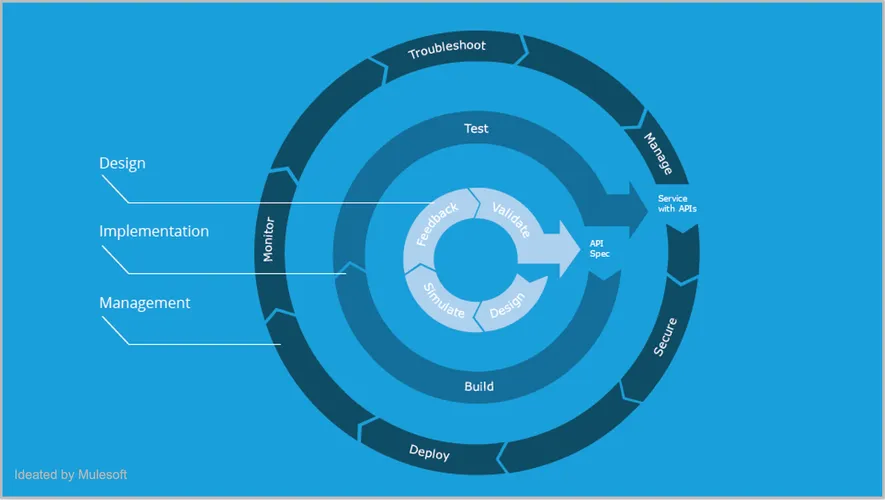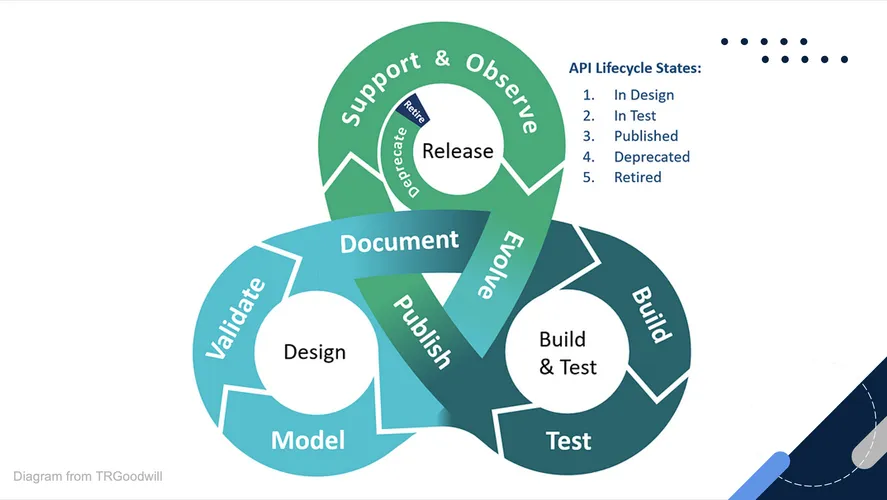Accelerate API-first workflows
API-first or Spec-driven development often follows a clear lifecycle; from defining your OpenAPI spec to monitoring production traffic.
I talk about API-first or Spec-driven development in blog posts like “An introduction to spec-driven API development” at Apideck and at several Meetups (“Unlocking the Power of Spec-Driven API Development”)

The concept was nicely visualised by this diagram from Mulesoft (a long time ago), where the API spec is used as a starting point.
With 3 clear stages: Design, Implementation, Management
- Design: The creation of the specification API contracts, with designing, simulating it with Mocks, Collect feedback from stakeholders & validate with linting (is it valid)
- Implementation: Development of code & validation (testing) to match the Spec. Refine the specification to match the final result
- Management: The stage where you deploy & monitor the API
This can also be linked to API Lifecycle Management, like the excellent explanation by TR Goodwill from 2022, resulting in very similar stages but with some small nuances

- Design: The creation of the specification API contracts, with validation and documentation creation
- Build & Test: Development of code & validation (testing) to match the Spec. Refine the specification or application to publish the final result
- Release: The stage where you deploy & monitor the API, and evolve to keep everything up-to-date but also sunset parts of the API
Inspectr fits into each stage, providing tooling that saves time and reduces friction.
Build Stage – Design & Mocking
Section titled “Build Stage – Design & Mocking”Before any code is written, you can use Inspectr’s Mocking with OpenAPI feature to validate your API design. With the --mock-backend flag, Inspectr serves responses directly from your specification, even when no backend exists.
inspectr --mock-backend=./openapi.yamlDynamic mocks are also available via --mock-dynamic=true, letting frontend and SDK teams iterate immediately.
Benefits
- Get started in minutes to iterate and try the model the while designing and specifying the endpoints.
- Start frontend work while the backend is still in progress.
- Skip deploying a temporary staging service just to try out your spec and cut hours of setting up that environment.
Build Stage – Local Development
Section titled “Build Stage – Local Development”During implementation, Inspectr acts as a real-time proxy and traffic inspector. As documented in the Key Features list, it provides Real-Time Proxying, a live UI Dashboard, and the ability to Replay Requests. Start Inspectr alongside your backend to capture each request and response:
inspectr --backend=http://localhost:3000Every operation is stored locally and visible in the app at http://localhost:4004.
Benefits
- Instant visibility into each request/response without extra logging code.
- Replay failed calls to debug issues faster than re-running your entire test suite.
Build Stage – Testing
Section titled “Build Stage – Testing”Need to simulate errors or latency? Inspectr supports Response Overrides so you can force specific status codes or delays without touching your code. When you’re ready to test webhooks or third‑party callbacks, run Inspectr with --catch=true and optionally --expose to create a public endpoint:
inspectr --catch=true --expose --channel=test-api --channel-code=secret123This exposes a secure URL such as https://test-api.in-spectr.dev for remote services while logging everything in real time.
Benefits
- Validate integrations quickly without setting up a full staging environment.
- Simulate failures and edge cases to see how your API handles them before going live, saving hours of manual testing.
Build Stage – Pre‑Deployment Demos
Section titled “Build Stage – Pre‑Deployment Demos”The Inspectr Ingress also streamlines staging reviews. By using --expose, teammates and stakeholders can interact with your local build before it’s deployed. The exposed URL live only for the duration of your session, so there’s no cleanup required.
Benefits
- Share feature previews instantly, saving time normally spent pushing to remote staging.
- Gather feedback earlier, reducing the number of deployment cycles.
Build Release – Monitoring & Troubleshooting
Section titled “Build Release – Monitoring & Troubleshooting”Inspectr keeps a history of every operation. As described in the Architecture docs, historical requests and responses can be kept. This history enables quick search and replay to reproduce issues even after they occur.
Benefits
- Persist request history so you can troubleshoot issues days instead of wasting time recreating scenarios.
- Replay any call to reproduce bugs without needing to capture fresh traffic, speeding up root-cause analysis.
By using Inspectr during each phase: Design, Build & Test and Release; you gain time spent on technical plumbing, have shorter feedback loops and gain visibility across your entire API lifecycle.
